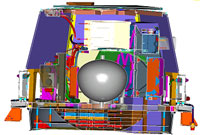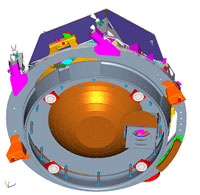Too Much of a Good Thing
by Ray Brown
November 7, 2003
Comets are believed to be the least evolved members of the Solar System. In order to discover their nature and that of the early solar system, the Deep Impact Mission will punch a hole in comet Tempel 1 and take a look at what's inside.
It works like this: The combination of a flyby spacecraft and an impactor spacecraft will be lifted from Earth by a Delta II rocket and the flyby spacecraft carrying the attached impactor will be on its way to intercept Tempel 1. As the duo closes in, the impactor separates from the flyby spacecraft and maneuvers itself into the path of the onrushing comet. Pictures of the comet before, during and after the collision will be transmitted to Earth for study.
That's the plan but an unusual problem came up during construction of the impactor spacecraft. Spacecraft builders' typical concern is that the spacecraft will be too heavy. But in this case two computer-related modules weighed in about five kilograms light. In addition, several other components weighed in light, bringing the total underweight to about ten kilograms, almost equivalent to a 25-pound bag of flour (22 pounds actually).
According to Jeremy Stober, Flight Impactor Systems Engineer at Ball Aerospace Corporation, routine weight monitoring signaled that changes were necessary. However, a final decision had to wait until balance testing was under way. What should be done? Add more weight like you would to handicap a racehorse? Replace an instrument with a heavier but more capable one? The solution to the problem is counterintuitive, as we shall see.
Any changes the flight system team makes must conform to some general constraints. For example, changes must not affect the launch-time, which is limited to a relatively narrow window. A cost ceiling and a limit on total weight of the flight system also restrict the scope of changes.
Other constraints also apply. The most important ones concern the location of the center of mass. To see why consider an analogy. Imagine that you're pushing a shopping cart that has its contents piled evenly in the basket. The cart's center of mass is near the middle of the pile if the cart doesn't weigh much. Choose the centerline of the cart to go straight ahead through the midpoint of the handle. When you push straight ahead on the midpoint of the handle the cart will move straight ahead. However, if most of the contents are piled on one side of the cart it will not move straight ahead but will wander off toward the heavy side. This is because the cart's center of mass is no longer on its centerline. There is a relationship between the center of mass and the direction of push that you must account for when steering the cart.
The impactor behaves similarly. There must be a relationship between the direction of thrust and the center of mass of the impactor so that the SCU (Spacecraft Control Unit) can determine how to turn on the thrusters. More specifically, the center of mass must be close to the centerline of the impactor and be at a certain position along its centerline. Unfortunately, the lighter impactor satisfied neither of these requirements.
There are two sets of options for restoring the center of mass to its required position. One set of options involves adding mass to the light end of the impactor. The light end is the aft (back) end of the impactor as it points itself toward the comet. The team could simply bond extra material to the units that were under weight. However, suitable bonding agents were of uncertain reliability so the team decided against that option. Another aft-end change could be to add mass to the table upon which one of the light components, the Spacecraft Control Unit, is mounted.
The MOI (Moment Of Inertia) plate also resides at the aft end. It provides extra mass for the thrusters to work against in order to prevent the impactor from overshooting when it maneuvers. The MOI affords a good place to add mass.
The team focused its attention on the battery (a third component in the aft end). Although the battery itself cannot be changed, its mounting might be. The team could increase the thickness of the thermal isolators that are positioned between the battery and its support but the strength of the connection would be in jeopardy. In addition, they could attach a weight to the battery itself but that would cause heat dissipation problems.
The original battery design included a plate that would get rid of heat by radiating it into space. Although it was found later that the plate was not needed, mounting holes had already been provided. The mounting holes could be used to attach some additional mass but doing that would move the center of mass too far from the impactor's centerline.
Could the thrusters be realigned in order to compensate for the shift in the center of mass? No, it is too late and would introduce uncertainties in maneuvering capability. In any case, it would not help much.
So far, the best bet is to add mass to the Moment of Inertia Plate. Yet the impactor would still be nose heavy. To correct that problem some mass must be removed from the fore (front) end.
The second set of options involves the fore end of the impactor, which contains the cratering body that will punch the hole in comet Tempel 1. The cratering body consists of a set of concentric copper/aluminum discs. In order to make the fore end lighter the team considered removing mass from the cratering body. Since it is at the fore end, making it lighter will cause the center of mass to move aft toward its required position.
In order to make the fore end lighter, the design team considered two options for removing mass from the cratering body. One option is to machine material from the discs. There was already a plan to do this. The other option was to omit one of the two front discs. The team elected to remove the front disc because some thruster supports will be attached to the second disc. Deleting the second disc and moving the support points to the front disc would involve significant time and effort.
There is another significant constraint on mass besides those on the center of mass: the mass of the impactor must be greater than 350 kilograms and equal to 370 kilograms if possible.
The size and shape of the cratering body levy another constraint. In order to form a crater of the desired size and shape, the cratering body should be hemispherical with a diameter of one half meter (about 20 inches) and a density as high as possible. Since the cratering body is not a complete hemisphere there are limits on its diameter to depth ratio.
The original design team had to restrict their choice of materials used in constructing the impactor. The reason is that in order to discover what kind of material the comet is made of, instruments on the flyby spacecraft will pass light from the collision through filters of different colors. Later scientists will analyze the resulting images. However, materials in the impactor itself contribute to the colors that are recorded. Accordingly, designers must limit the amount of certain elements such as aluminum, magnesium in the impactor.
Having considered all the factors above, the flight system engineers' final decision was to make three changes that can be accomplished within a reasonable time and with reasonable effort:
- Omit the battery radiator plate that is no longer needed (aft)
- Increase the mass of the Moment Of Inertia plate (aft)
- Omit the foremost disc of the cratering body (fore)
These changes are made to satisfy the following major constraints. (1) The mass of the impactor must be greater than 350 kg. (It will be about 360 kilograms.) (2) When measured along the centerline, the distance between the center of mass and a reference point shall be less than one centimeter. (3) When measured along a line perpendicular to the centerline, the distance between the center of mass and the centerline shall be less than 1.3 millimeter.
The irony of the situation is that because some impactor components weighed less than expected, it was necessary to reduce the impactor's weight even further to maintain its balance.
Read the related Braintwister.














